So what we want is to obtain the 4 intersection points between our plane (Z=0.0) and camera frustrum. So the idea is to cast 4 rays (one for each edge of frustrum) from the camera focal point and simply compute the ray/plane intersection. As the plane is Z=0.0 the intersection point has Z=0.0 too so the intersection is quite easy to compute.
Cast ray for each corner/edge
from camera focal point to screen corner (in screen space)

and convert it to world global coordinates (by reverting perspective and using inverse modelview matrix it is described later). The ray should be in form:
p(t) = p + dp*t
where p is the focal point and dp is direction vector (does not need to be normalized)
compute the intersection with XY plane (Z=0.0)
As the z=0.0 then:
0 = p.z + dp.z*t
t = -p.z/dp.z
so we can compute the intersection point directly.
convert 3D intersection points to u,v inside map
for that simple dot product is enough. So if p is our intersection point then:
u = dot(p-p0,du)
v = dot(p-p0,dv)
where u,v are coordinates in our 2D map array or minimap. In case your u,v are axis aligned then you can use directly (p.x-p0.x,p.y-p0.y) without any dot product
How to convert point p from camera coordinates to global world coordinates:
revert perspective
first obtain perspective matrix parameters
double per[16],zNear,zFar,fx,fy;
glGetDoublev(GL_PROJECTION_MATRIX,per);
zFar =0.5*per[14]*(1.0-((per[10]-1.0)/(per[10]+1.0)));
zNear=zFar*(per[10]+1.0)/(per[10]-1.0);
fx=per[0];
fy=per[5];
This will give you the frustrums near and far planes and scaling for x,y axises. Now reverting perspective is simply inverting the perspective divide like this:
p[1]*=(-p[2]/fy); // apply inverse of perspective
p[0]*=(-p[2]/fx);
The znear and zfar are needed for casting the rays. For more info see:
global world coordinates
simply use inverse of ModelView matrix on our p. So first obtain the matrix:
double cam[16];
glGetDoublev(GL_MODELVIEW_MATRIX,cam);
As inverse you can use my matrix_inv so now the final step is:
p = Inverse(cam)*p;
but do not forget that p must be homogenuous so (x,y,z,1) for points and (x,y,z,0) for vectors.
Look here if you lack the background knowledge or need vector/matrix math:
Here Small C++ example of this:
//---------------------------------------------------------------------------
void matrix_mul_vector(double *c,double *a,double *b)
{
double q[3];
q[0]=(a[ 0]*b[0])+(a[ 4]*b[1])+(a[ 8]*b[2])+(a[12]);
q[1]=(a[ 1]*b[0])+(a[ 5]*b[1])+(a[ 9]*b[2])+(a[13]);
q[2]=(a[ 2]*b[0])+(a[ 6]*b[1])+(a[10]*b[2])+(a[14]);
for(int i=0;i<3;i++) c[i]=q[i];
}
//---------------------------------------------------------------------------
void matrix_inv(double *a,double *b) // a[16] = Inverse(b[16])
{
double x,y,z;
// transpose of rotation matrix
a[ 0]=b[ 0];
a[ 5]=b[ 5];
a[10]=b[10];
x=b[1]; a[1]=b[4]; a[4]=x;
x=b[2]; a[2]=b[8]; a[8]=x;
x=b[6]; a[6]=b[9]; a[9]=x;
// copy projection part
a[ 3]=b[ 3];
a[ 7]=b[ 7];
a[11]=b[11];
a[15]=b[15];
// convert origin: new_pos = - new_rotation_matrix * old_pos
x=(a[ 0]*b[12])+(a[ 4]*b[13])+(a[ 8]*b[14]);
y=(a[ 1]*b[12])+(a[ 5]*b[13])+(a[ 9]*b[14]);
z=(a[ 2]*b[12])+(a[ 6]*b[13])+(a[10]*b[14]);
a[12]=-x;
a[13]=-y;
a[14]=-z;
}
//---------------------------------------------------------------------------
void draw_map()
{
int i,j;
double u,v,p[3],dp[3];
// here 3D view must be already set (modelview,projection)
glDisable(GL_CULL_FACE);
// [draw 3D map]
const int n=30; // map size
double p0[3]={0.0,0.0,0.0}; // map start point
double du[3]={1.0,0.0,0.0}; // map u step (size of grid = 1.0 )
double dv[3]={0.0,1.0,0.0}; // map v step (size of grid = 1.0 )
glColor3f(0.5,0.7,1.0);
glBegin(GL_LINES);
for (j=0;j<=n;j++)
{
for (i=0;i<3;i++) p[i]=p0[i]+(double(j)*du[i])+(double(0)*dv[i]); glVertex3dv(p);
for (i=0;i<3;i++) p[i]=p0[i]+(double(j)*du[i])+(double(n)*dv[i]); glVertex3dv(p);
for (i=0;i<3;i++) p[i]=p0[i]+(double(0)*du[i])+(double(j)*dv[i]); glVertex3dv(p);
for (i=0;i<3;i++) p[i]=p0[i]+(double(n)*du[i])+(double(j)*dv[i]); glVertex3dv(p);
}
glEnd();
// [compute trapeze points]
double cam[16],per[16],pt[4][3],zNear,zFar,fx,fy;
glGetDoublev(GL_PROJECTION_MATRIX,per); // obtain matrices
glGetDoublev(GL_MODELVIEW_MATRIX,cam);
matrix_inv(cam,cam);
zFar =0.5*per[14]*(1.0-((per[10]-1.0)/(per[10]+1.0)));
zNear=zFar*(per[10]+1.0)/(per[10]-1.0);
fx=per[0];
fy=per[5];
for (j=0;j<4;j++) // 4 corners
{
for (i=0;i<3;i++) dp[i]=0.0; // cast ray from camera focus dp
if (j==0) { p[0]=-1.0; p[1]=-1.0; } // to screen corner p
if (j==1) { p[0]=-1.0; p[1]=+1.0; }
if (j==2) { p[0]=+1.0; p[1]=+1.0; }
if (j==3) { p[0]=+1.0; p[1]=-1.0; }
p[2]=zNear; // start position at screen plane
p[1]*=(-p[2]/fy); // apply inverse of perspective
p[0]*=(-p[2]/fx);
// transform to worlds global coordinates
matrix_mul_vector( p,cam, p);
matrix_mul_vector(dp,cam,dp);
// compute intersection of ray and XY plane (z=0) as pt[j] (i exploited the fact that the intersection have z=0.0 for arbitrary plane it would be a bit more complicated)
for (i=0;i<3;i++) dp[i]=p[i]-dp[i];
u=p[2]/dp[2];
if (u<0.0) u=(p[2]-zFar)/dp[2]; // no intersection means "infinite" visibility
for (i=0;i<3;i++) pt[j][i]=p[i]-(u*dp[i]);
u=0.0;
}
// [draw 2D minimap]
GLint vp0[4];
GLint vp1[4]={10,10,150,150}; // minimap position and size ppixels[
double q0[2]={-1.0,-1.0 }; // minimap start point
double eu[2]={2.0/double(n),0.0}; // minimap u step
double ev[2]={0.0,2.0/double(n)}; // minimap v step
// set 2D view for minimap
glDisable(GL_DEPTH_TEST);
glMatrixMode(GL_PROJECTION);
glPushMatrix();
glLoadIdentity();
glMatrixMode(GL_MODELVIEW);
glPushMatrix();
glLoadIdentity();
glGetIntegerv(GL_VIEWPORT,vp0);
glViewport(vp1[0],vp1[1],vp1[2],vp1[3]);
glColor3f(0.0,0.0,0.0); // clear background
glBegin(GL_QUADS);
for (i=0;i<2;i++) p[i]=q0[i]+(double(0)*eu[i])+(double(0)*ev[i]); glVertex2dv(p);
for (i=0;i<2;i++) p[i]=q0[i]+(double(n)*eu[i])+(double(0)*ev[i]); glVertex2dv(p);
for (i=0;i<2;i++) p[i]=q0[i]+(double(n)*eu[i])+(double(n)*ev[i]); glVertex2dv(p);
for (i=0;i<2;i++) p[i]=q0[i]+(double(0)*eu[i])+(double(n)*ev[i]); glVertex2dv(p);
glEnd();
glColor3f(0.15,0.15,0.15); // grid
glBegin(GL_LINES);
for (j=0;j<=n;j++)
{
for (i=0;i<2;i++) p[i]=q0[i]+(double(j)*eu[i])+(double(0)*ev[i]); glVertex2dv(p);
for (i=0;i<2;i++) p[i]=q0[i]+(double(j)*eu[i])+(double(n)*ev[i]); glVertex2dv(p);
for (i=0;i<2;i++) p[i]=q0[i]+(double(0)*eu[i])+(double(j)*ev[i]); glVertex2dv(p);
for (i=0;i<2;i++) p[i]=q0[i]+(double(n)*eu[i])+(double(j)*ev[i]); glVertex2dv(p);
}
glEnd();
glColor3f(0.5,0.5,0.5); // border of minimap
glLineWidth(2.0);
glBegin(GL_LINE_LOOP);
for (i=0;i<2;i++) p[i]=q0[i]+(double(0)*eu[i])+(double(0)*ev[i]); glVertex2dv(p);
for (i=0;i<2;i++) p[i]=q0[i]+(double(n)*eu[i])+(double(0)*ev[i]); glVertex2dv(p);
for (i=0;i<2;i++) p[i]=q0[i]+(double(n)*eu[i])+(double(n)*ev[i]); glVertex2dv(p);
for (i=0;i<2;i++) p[i]=q0[i]+(double(0)*eu[i])+(double(n)*ev[i]); glVertex2dv(p);
glEnd();
glLineWidth(1.0);
// 2D minimap render of the pt[]
glColor3f(0.7,0.1,0.1); // trapeze
glBegin(GL_LINE_LOOP);
for (j=0;j<4;j++)
{
// get u,v from pt[j]
for (i=0;i<3;i++) p[i]=pt[j][i]-p0[i];
for (u=0.0,i=0;i<3;i++) u+=p[i]*du[i];
for (v=0.0,i=0;i<3;i++) v+=p[i]*dv[i];
// convert to 2D position and render
for (i=0;i<2;i++) p[i]=q0[i]+(u*eu[i])+(v*ev[i]); glVertex2dv(p);
}
glEnd();
// restore 3D view
glMatrixMode(GL_MODELVIEW);
glPopMatrix();
glMatrixMode(GL_PROJECTION);
glPopMatrix();
glViewport(vp0[0],vp0[1],vp0[2],vp0[3]);
glEnable(GL_DEPTH_TEST);
}
//---------------------------------------------------------------------------
And preview:

As you can see we need just matrix*vector multiplication and pseudo inverse matrix functions for this (all others like dot,+,- are really simple and directly encoded as inline code) and both are simple enough to directly implement it in code so no need for GLM or similar lib.
Also I was too lazy to clip the 4 point polygon to minimap size so instead I used glViewport which did it for me.
Here Win32 BDS2006 VCL/C++/OpenGL1.0 Demo:
Just select slow download and enter the validation code from image. It does not use any 3th party libs other than GL,GLU. The camera is static so just add keyboard/mouse events to your liking. If you want to port this to your environment just mimic the events behavior and ignore the VCL stuff.
The OpenGL init is done based on this:
I just removed the GLEW,GLSL and VAO stuff from it.


